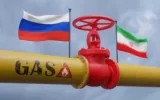The prospect of importing gas from Russia to Iran; Lagging behind global and regional markets

According to the exclusive report of Energy Press, reports broadcast in July that Iran imports 300 million cubic meters of gas annually from Russia may seem strange to many, especially considering that Tehran is one of the largest exporters of energy resources. is in the region. Meanwhile, Russian President Vladimir Putin told reporters on Thursday during the Eastern Economic Forum that Iran has been asking Russia to supply gas to the country for a long time.
Iran’s oil minister at the time, Javad Oji, called this agreement a “masterpiece of energy diplomacy”. But many analysts wondered why a country that has the world’s second-largest gas reserves – 17 percent – and 9.54 percent of the world’s oil reserves, should be rejected by many countries after the invasion of Ukraine in 2022. was, to bring energy.
According to the report of Stimons think tank, sanctions, lack of investment and mismanagement have plagued Iran’s energy industry for years. Iran has been importing gas from its neighbor Turkmenistan for a long time, which has occasionally cut off its gas flow to Iran due to non-reimbursement.
Effects of sanctions: retardation and standing
Iran’s neighbors, who are not under the burden of sanctions, have been able to increase their energy production capacity during the last two decades with the help of foreign investment and technology. This is particularly bad news for Iran because it shares many oil and gas fields with neighboring countries, and increased production there means a decrease in Iran’s potential revenues.
Iran shares 28 fields with its neighbors, 15 of which are under the waters of the Persian Gulf. Iran has 12 fields with Iraq, five fields with the United Arab Emirates, four fields with Saudi Arabia, four fields with Qatar and one common field with Oman, Kuwait and Turkmenistan.
On average, 6.5 billion dollars have been invested annually in the oil industry in the last 2.5 years. According to the Iranian Parliament Research Center, the annual investment in Iran’s upstream oil and gas projects has decreased from about 18 billion dollars in the 1990s to 7 billion dollars in the early 2010s and to 3 billion dollars since 2017.
In order to prevent a rapid decrease in oil production, Iran needs to re-inject nearly 300 million cubic meters of gas per day into its old oil reserves. However, the latest available official data shows that in 2017, gas re-injection was at best 80-90 million cubic meters. According to the announcement of the Majlis Research Center in 2017, if the gas required for injection is not supplied, 2.3 to 2.7 billion barrels of crude oil will be locked in the reservoir and will never be extracted. At $50 per barrel, a fortune of $115-135 billion is probably out of reach.
Tags:gas
- Comments sent by you will be published after approval by site administrators.
- Comments that contain slander will not be published.
- Comments that are not in Persian or not related to the news will not be published.

Comments
Total comments : 0 Awaiting review : 0 Date: 0